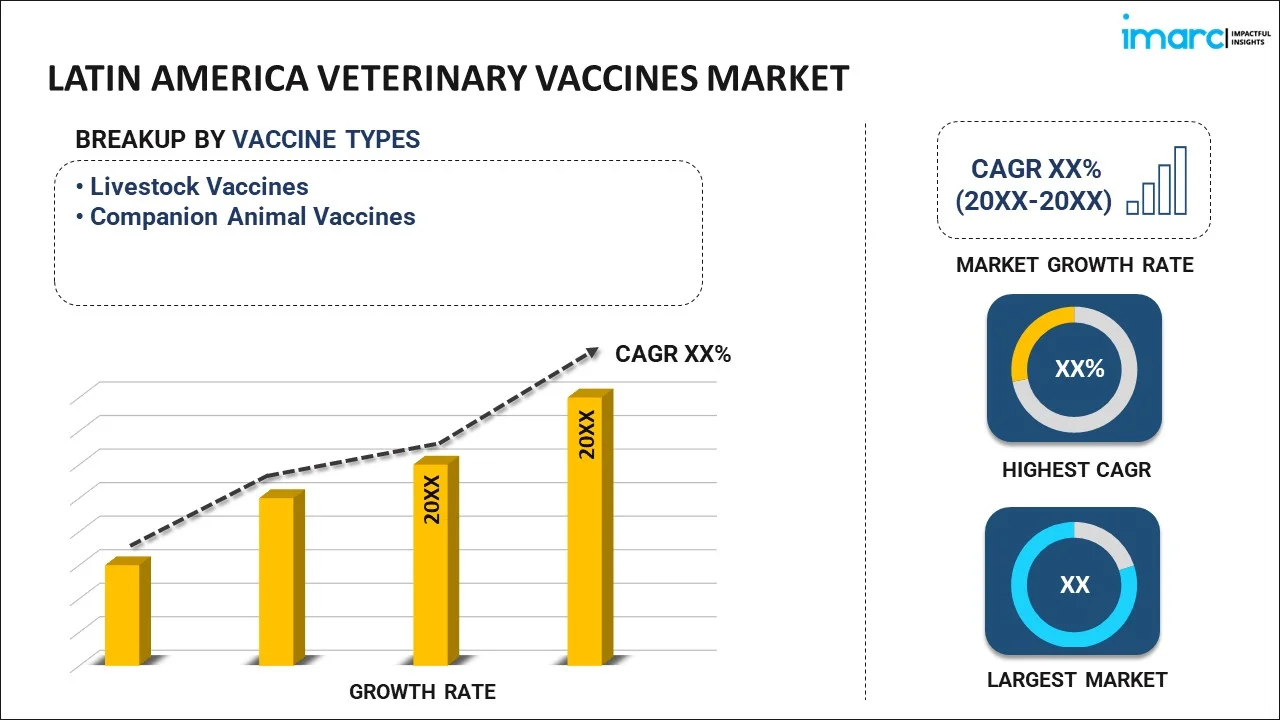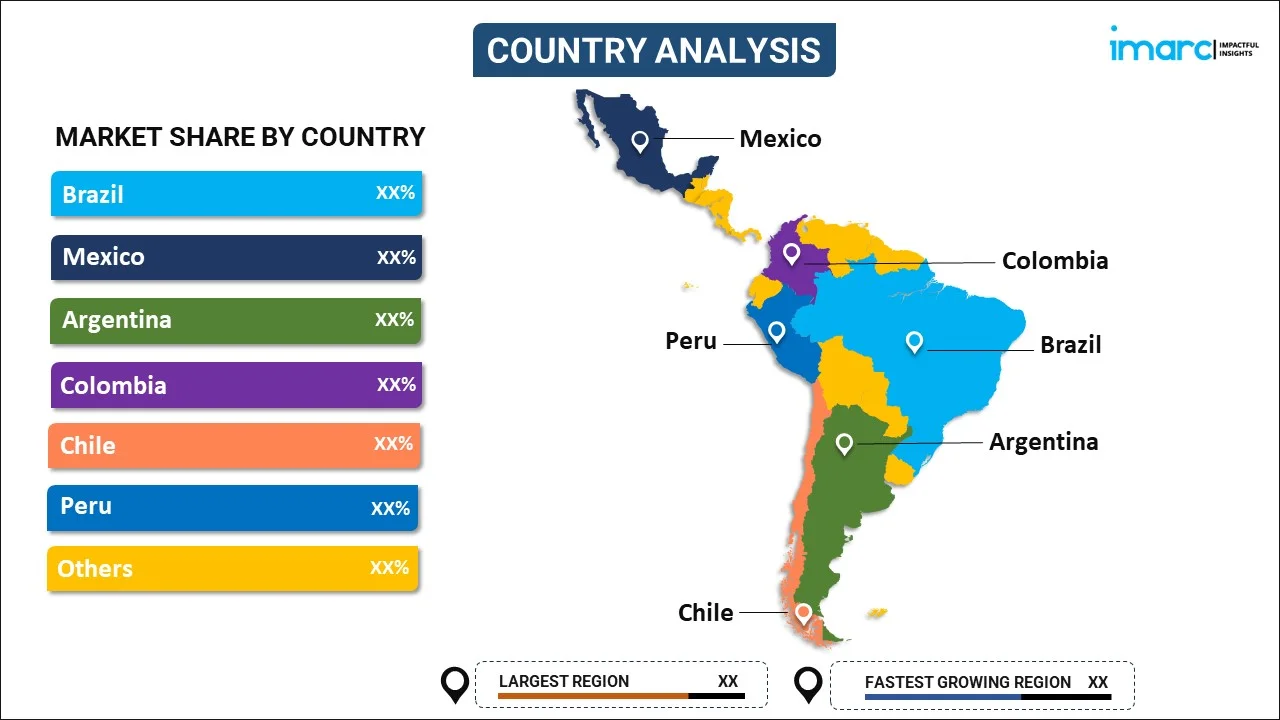
Latin America Veterinary Vaccines Market Report by Vaccine Type (Livestock Vaccines, Companion Animal Vaccines), Technology (Attenuated Live Vaccines, Inactivated Vaccines, Toxoid Vaccines, Recombinant Vaccines, and Others), Route of Administration (Subcutaneous, Intramuscular, Intranasal), Distribution Channel (Veterinary Hospitals, Veterinary Clinics, Pharmacies and Drug Stores, and Others), and Country 2025-2033
Market Overview:
Latin America veterinary vaccines market size reached USD 1.6 Billion in 2024. Looking forward, IMARC Group expects the market to reach USD 2.8 Billion by 2033, exhibiting a growth rate (CAGR) of 6.2% during 2025-2033. The increasing advances in vaccine technologies, including the development of new and improved vaccine formulations, adjuvants, and delivery systems, which enhance the effectiveness and safety of veterinary vaccines, are driving the market.
|
Report Attribute
|
Key Statistics
|
|---|---|
|
Base Year
|
2024 |
|
Forecast Years
|
2025-2033
|
|
Historical Years
|
2019-2024
|
| Market Size in 2024 | USD 1.6 Billion |
| Market Forecast in 2033 | USD 2.8 Billion |
| Market Growth Rate (2025-2033) | 6.2% |
Veterinary vaccines are crucial tools in safeguarding the health of animals, preventing the spread of infectious diseases, and ensuring the well-being of both domestic and wild species. These vaccines are specially formulated to stimulate an immune response in animals, leading to the production of antibodies that protect against specific pathogens. Common veterinary vaccines target diseases such as rabies, distemper, parvovirus, and respiratory infections in animals like dogs, cats, and livestock. Additionally, vaccines are essential in controlling and eradicating contagious diseases that can have significant economic and ecological impacts. The development and administration of veterinary vaccines require careful consideration of species-specific factors, and ongoing research continues to improve vaccine efficacy, safety, and accessibility for a diverse range of animal populations. Ultimately, veterinary vaccines play a vital role in promoting animal health, preventing the transmission of diseases between animals and humans, and maintaining a harmonious balance within ecosystems.
Latin America Veterinary Vaccines Market Trends:
The veterinary vaccines market in Latin America is experiencing robust growth due to several key drivers. Firstly, the increasing awareness about animal health and welfare has propelled the demand for preventive measures, fostering the market's expansion. Additionally, the rising incidence of infectious diseases among animals has underscored the necessity for effective vaccination, driving the market forward. Moreover, stringent regulations and guidelines imposed by regulatory authorities to ensure the well-being of animals further augment the demand for veterinary vaccines. Furthermore, advancements in biotechnology and the continuous R&D efforts in the field have led to the introduction of innovative and more efficacious vaccines, positively influencing market dynamics. Concurrently, the growing regional population and the subsequent rise in demand for animal-derived products have increased the need for efficient disease prevention in livestock, contributing to the escalating demand for veterinary vaccines. In parallel, the surge in pet ownership and the evolving role of pets as integral members of families have propelled the demand for companion animal vaccines. These interconnected factors collectively drive the veterinary vaccines market in Latin America, creating a landscape characterized by sustained growth and a focus on improving overall animal health.
Latin America Veterinary Vaccines Market Segmentation:
IMARC Group provides an analysis of the key trends in each segment of the market, along with forecasts at the regional and country levels for 2025-2033. Our report has categorized the market based on vaccine type, technology, route of administration, and distribution channel.
Vaccine Type Insights:

- Livestock Vaccines
- Bovine Vaccines
- Poultry Vaccines
- Porcine Vaccines
- Others
- Companion Animal Vaccines
- Canine Vaccines
- Feline Vaccines
- Equine Vaccines
The report has provided a detailed breakup and analysis of the market based on the vaccine type. This includes livestock vaccines (bovine vaccines, poultry vaccines, porcine vaccines, and others) and companion animal vaccines (canine vaccines, feline vaccines, and equine vaccines).
Technology Insights:
- Attenuated Live Vaccines
- Inactivated Vaccines
- Toxoid Vaccines
- Recombinant Vaccines
- Others
A detailed breakup and analysis of the market based on the technology have also been provided in the report. This includes attenuated live vaccines, inactivated vaccines, toxoid vaccines, recombinant vaccines, and others.
Route of Administration Insights:
- Subcutaneous
- Intramuscular
- Intranasal
The report has provided a detailed breakup and analysis of the market based on the route of administration. This includes subcutaneous, intramuscular, and intranasal.
Distribution Channel Insights:
- Veterinary Hospitals
- Veterinary Clinics
- Pharmacies and Drug Stores
- Others
A detailed breakup and analysis of the market based on the distribution channel have also been provided in the report. This includes veterinary hospitals, veterinary clinics, pharmacies and drug stores, and others.
Country Insights:

- Brazil
- Mexico
- Argentina
- Colombia
- Chile
- Peru
- Others
The report has also provided a comprehensive analysis of all the major regional markets, which include Brazil, Mexico, Argentina, Colombia, Chile, Peru, and Others.
Competitive Landscape:
The market research report has also provided a comprehensive analysis of the competitive landscape. Competitive analysis such as market structure, key player positioning, top winning strategies, competitive dashboard, and company evaluation quadrant has been covered in the report. Also, detailed profiles of all major companies have been provided.
Latin America Veterinary Vaccines Market Report Coverage:
| Report Features | Details |
|---|---|
| Base Year of the Analysis | 2024 |
| Historical Period | 2019-2024 |
| Forecast Period | 2025-2033 |
| Units | Billion USD |
| Scope of the Report | Exploration of Historical and Forecast Trends, Industry Catalysts and Challenges, Segment-Wise Historical and Predictive Market Assessment:
|
| Vaccine Types Covered |
|
| Technologies Covered | Attenuated Live Vaccines, Inactivated Vaccines, Toxoid Vaccines, Recombinant Vaccines, Others |
| Route of Administrations Covered | Subcutaneous, Intramuscular, Intranasal |
| Distribution Channels Covered | Veterinary Hospitals, Veterinary Clinics, Pharmacies and Drug Stores, Others |
| Countries Covered | Brazil, Mexico, Argentina, Colombia, Chile, Peru, Others |
| Customization Scope | 10% Free Customization |
| Post-Sale Analyst Support | 10-12 Weeks |
| Delivery Format | PDF and Excel through Email (We can also provide the editable version of the report in PPT/Word format on special request) |
Key Questions Answered in This Report:
- How has the Latin America veterinary vaccines market performed so far and how will it perform in the coming years?
- What has been the impact of COVID-19 on the Latin America veterinary vaccines market?
- What is the breakup of the Latin America veterinary vaccines market on the basis of vaccine type?
- What is the breakup of the Latin America veterinary vaccines market on the basis of technology?
- What is the breakup of the Latin America veterinary vaccines market on the basis of route of administration?
- What is the breakup of the Latin America veterinary vaccines market on the basis of distribution channel?
- What are the various stages in the value chain of the Latin America veterinary vaccines market?
- What are the key driving factors and challenges in the Latin America veterinary vaccines?
- What is the structure of the Latin America veterinary vaccines market and who are the key players?
- What is the degree of competition in the Latin America veterinary vaccines market?
Key Benefits for Stakeholders:
- IMARC’s industry report offers a comprehensive quantitative analysis of various market segments, historical and current market trends, market forecasts, and dynamics of the Latin America veterinary vaccines market from 2019-2033.
- The research report provides the latest information on the market drivers, challenges, and opportunities in the Latin America veterinary vaccines market.
- Porter's five forces analysis assist stakeholders in assessing the impact of new entrants, competitive rivalry, supplier power, buyer power, and the threat of substitution. It helps stakeholders to analyze the level of competition within the Latin America veterinary vaccines industry and its attractiveness.
- Competitive landscape allows stakeholders to understand their competitive environment and provides an insight into the current positions of key players in the market.
Need more help?
- Speak to our experienced analysts for insights on the current market scenarios.
- Include additional segments and countries to customize the report as per your requirement.
- Gain an unparalleled competitive advantage in your domain by understanding how to utilize the report and positively impacting your operations and revenue.
- For further assistance, please connect with our analysts.
 Request Customization
Request Customization
 Speak to an Analyst
Speak to an Analyst
 Request Brochure
Request Brochure
 Inquire Before Buying
Inquire Before Buying




.webp)




.webp)












